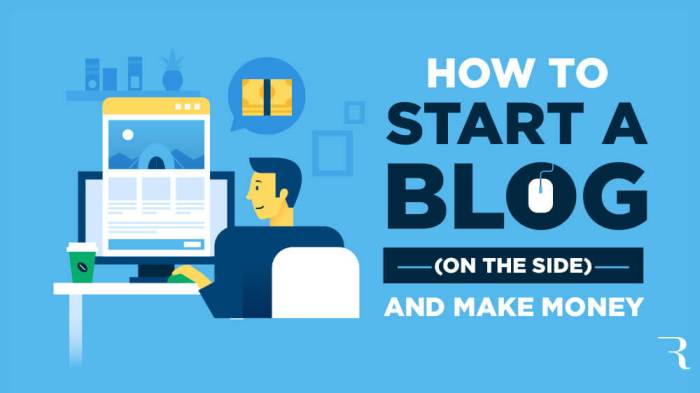How to Start a Blog sets the stage for your online journey, exploring the ins and outs of creating a successful blog with flair and finesse. Dive in and discover the secrets to crafting a captivating online presence that stands out from the crowd.
In this guide, we’ll cover everything from selecting a niche to designing your blog and creating quality content that resonates with your audience. Get ready to unleash your creativity and make your mark in the blogosphere!
Introduction to Blogging
A blog is a regularly updated website or online platform where individuals or groups of people share their thoughts, opinions, experiences, and expertise on various topics. The purpose of a blog is to provide valuable content to readers, engage with an audience, and establish authority in a particular niche.
Why Individuals Start Blogs
- To share knowledge and expertise with others in a specific field or interest.
- To express creativity and showcase talents such as writing, photography, or design.
- To connect with like-minded individuals and build a community around shared interests.
Benefits of Having a Blog
- Building an Online Presence: A blog allows individuals to establish themselves as experts in their field and gain recognition.
- Monetization Opportunities: Bloggers can earn income through partnerships, sponsorships, affiliate marketing, and advertising on their platform.
- Personal Growth: Blogging helps individuals improve their writing, communication, and digital skills.
Planning Your Blog

When starting a blog, it’s essential to plan ahead to ensure its success. This involves choosing a niche, defining your target audience, and coming up with a unique angle for your blog.
Choosing a Niche for Your Blog
Finding the right niche for your blog is crucial to attract the right audience and stand out in the crowded online space. Consider your interests, expertise, and what topics you are passionate about. Research trending topics and see where there is a gap that you can fill with your unique perspective.
Defining Your Target Audience
Understanding your target audience is key to creating content that resonates with them. Consider the demographics, interests, and needs of your ideal readers. Tailor your content to address their pain points and provide valuable information that keeps them coming back for more.
Coming Up with a Unique Angle for Your Blog
To differentiate your blog from others in the same niche, think about what makes you stand out. Consider your personal experiences, expertise, or a fresh perspective on a popular topic. Find a unique angle that sets your blog apart and makes it memorable to your audience.
Setting Up Your Blog

When it comes to setting up your blog, there are a few key steps you need to take to get started on the right foot.
Selecting a Blogging Platform
Choosing the right platform for your blog is crucial as it will determine the overall look, feel, and functionality of your site. Here are some steps to consider:
- Research different blogging platforms such as WordPress, Blogger, or Squarespace to find one that aligns with your needs and goals.
- Consider factors like ease of use, customization options, and available plugins or themes.
- Look into the pricing structure of each platform to ensure it fits within your budget.
Choosing a Domain Name
Your domain name is the web address where visitors can find your blog, so it’s important to choose one that is memorable and relevant to your content. Here’s how to select a domain name:
- Brainstorm potential names that reflect the topic or niche of your blog.
- Avoid using numbers or hyphens in your domain name as they can be confusing or hard to remember.
- Check the availability of your desired domain name using a domain registrar like GoDaddy or Namecheap.
Selecting a Reliable Web Hosting Service
A reliable web hosting service is essential for ensuring your blog is accessible to visitors at all times. Consider the following when choosing a hosting provider:
- Research hosting companies to find one with a good reputation for uptime, customer support, and security.
- Compare pricing plans and features offered by different hosting providers to find one that meets your needs.
- Consider scalability options in case your blog grows in the future and requires more resources.
Designing Your Blog: How To Start A Blog
When it comes to designing your blog, there are a few key aspects to consider in order to attract and retain readers. From selecting a visually appealing theme to creating a user-friendly layout, here are some tips to help you customize your blog and make it stand out from the crowd.
Selecting a Visually Appealing Blog Theme
Choosing the right theme is crucial as it sets the tone for your blog and creates a first impression for your readers. Here are some tips for selecting a visually appealing blog theme:
- Look for a theme that reflects your content and personality.
- Ensure the theme is mobile-responsive for users on different devices.
- Consider the overall layout, color scheme, and typography for a cohesive look.
Creating a User-Friendly Layout
A user-friendly layout is essential for keeping readers engaged and making navigation easy. Here’s how you can achieve this:
- Organize your content with clear categories and menus.
- Make sure your blog is easy to read with legible font sizes and spacing.
- Include search functionality to help users find specific content.
Customizing Your Blog to Reflect Your Brand
Customizing your blog to reflect your brand is key to building a strong identity and connecting with your audience. Here’s how you can do this:
- Use your brand colors, logo, and imagery consistently throughout your blog.
- Add personal touches like an about page or author bio to share your story.
- Showcase your expertise and unique perspective through your content and design choices.
Creating Quality Content
When it comes to creating a successful blog, one of the most important aspects is generating quality content that resonates with your audience. Here are some tips to help you create engaging and valuable content that will keep your readers coming back for more.
Generating Ideas for Blog Posts
- Brainstorm topics that you are passionate about or knowledgeable in.
- Stay updated on current trends and news in your niche for inspiration.
- Ask your audience for feedback and suggestions on what they would like to read about.
The Importance of Creating Engaging and Valuable Content, How to Start a Blog
- Engaging content keeps your readers interested and coming back for more.
- Valuable content provides useful information or solves a problem for your audience.
- Building trust and credibility with your audience through quality content.
Optimizing Your Content for Search Engines
- Use relevant s throughout your content to improve search engine visibility.
- Write clear and concise meta descriptions for each blog post.
- Create high-quality and shareable content to increase backlinks and improve .
Growing Your Blog
When it comes to growing your blog, there are several key strategies that can help you increase your visibility and attract more readers.
Promoting Your Blog on Social Media
- Utilize popular social media platforms like Facebook, Twitter, Instagram, and Pinterest to share your blog posts and engage with your audience.
- Create eye-catching graphics and captions to accompany your posts, making them more shareable and appealing.
- Join relevant social media groups and communities to connect with like-minded individuals and promote your blog within those circles.
Networking with Other Bloggers
- Collaborate with other bloggers in your niche by guest posting on their sites or hosting joint events or giveaways.
- Attend blogging conferences or meetups to network with industry professionals and gain valuable insights and connections.
- Engage with other bloggers through comments, shares, and shoutouts on social media to build relationships and expand your reach.
Increasing Your Blog’s Visibility and Readership
- Optimize your blog for search engines by using relevant s, meta descriptions, and alt tags to improve your ranking on Google.
- Promote your blog through email marketing campaigns to keep your subscribers updated on new content and drive traffic back to your site.
- Create engaging and shareable content that resonates with your target audience to encourage repeat visits and referrals.
